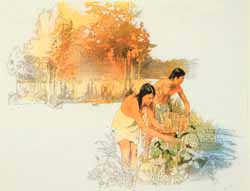
Early Archaic people found food in every part of their world. They hunted a variety of mammals such as white-tailed deer, squirrel, and rabbits where forest met the prairie. They also hunted waterfowl on prairie ponds and marshes, and on backwater lakes along streams and rivers. They fished in ponds, shallow lakes, streams, and rivers. These habitats also provided frogs, turtles, and freshwater mussels.
Plant foods were also an important part of the Early Archaic diet. In the spring, roots and tubers were the first plant foods to become available after a long winter. Summer brought a variety of berries and other plant foods. In the fall, nuts such as walnut (Juglans nigra), pecan (Carya illinoensis), and hickory (Carya), were an important source of protein and fat.
Middle Archaic people also hunted and gathered wild foods, but in some areas of Illinois they concentrated on aquatic resources such as fish and freshwater mussels, especially in the warm-weather months. These foods, and seed-bearing plants found in stream and river valleys, could be found in great quantities year after year.
 |
Artist's illustration of seed collecting. | |
|
When seeds ripened, Native Americans collected them in baskets and other containers. Beginning during the Archaic period, dense stands of seed-bearing plants played an increasingly important role in Native American economy. |
||
Late Archaic people hunted and gathered like their predecessors, but they supplemented their diet with cultivated plant foods. For example, archaeologists found sumpweed (Iva annua or marsh elder) seeds at the Napoleon Hollow site located on the Illinois River in Pike County. These particular seeds are much larger than those found in nature. Change in seed size is one indicator of cultivation.
How and why did Native Americans cultivate plants? Archaeologists do not yet have a complete answer. Some archaeologists believe increases in human population led Native people to explore new ways of creating a more stable food supply. Evidence of the origins of agriculture continues to accumulate, improving our understanding of one of the most important inventions in human history. Consider how much agriculture provides to our way of life today.
|
|
Copyright © 2000 Illinois State Museum